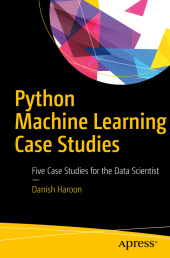 Neuerscheinungen 2017Stand: 2020-02-01 |
Schnellsuche
ISBN/Stichwort/Autor
|
Herderstraße 10
10625 Berlin
Tel.: 030 315 714 16
Fax 030 315 714 14
info@buchspektrum.de |

Danish Haroon
Python Machine Learning Case Studies
Five Case Studies for the Data Scientist
1st ed. 2017. xvii, 204 S. 21 SW-Abb., 99 Farbabb. 235 mm
Verlag/Jahr: SPRINGER, BERLIN; APRESS 2017
ISBN: 1-484-22822-7 (1484228227)
Neue ISBN: 978-1-484-22822-7 (9781484228227)
Preis und Lieferzeit: Bitte klicken
Embrace machine learning approaches and Python to enable automatic rendering of rich insights and solve business problems. The book uses a hands-on case study-based approach to crack real-world applications to which machine learning concepts can be applied. These smarter machines will enable your business processes to achieve efficiencies on minimal time and resources.
Python Machine Learning Case Studies takes you through the steps to improve business processes and determine the pivotal points that frame strategies. YouŽll see machine learning techniques that you can use to support your products and services. Moreover youŽll learn the pros and cons of each of the machine learning concepts to help you decide which one best suits your needs.
By taking a step-by-step approach to coding in Python youŽll be able to understand the rationale behind model selection and decisions within the machine learning process. The book is equipped with practical examples along with code snippets to ensure that you understand the data science approach to solving real-world problems.
What You Will Learn
Gain insights into machine learning concepts
Work on real-world applications of machine learning
Learn concepts of model selection and optimization
Get a hands-on overview of Python from a machine learning point of view
Who This Book Is For
Data scientists, data analysts, artificial intelligence engineers, big data enthusiasts, computer scientists, computer sciences students, and capital market analysts.
Chapter 1: Statistics and Probability Chapter Goal: Introduction and hands on approach to central limit theorem, distributions, confidence intervals, statistical tests, ROC curves, plots, probabilities, permutations and combinations No of pages: 70-80 Sub -Topics 1. Exploratory Data analysis 2. Probability Distributions 3. Concept of Permutations and Combinations 4. Statistical tests 5. Applications in the industry 6. Case study
Chapter 2: Regression Chapter Goal: Introduction and hands on approach to the concept of regression, linear regression models, non linear regression models. No of pages: 50-60 Sub - Topics 1. Concept of Regression 2. Linear regression 3. Polynomial order regression 4. Statistical tests 5. Applications in the industry 6. Case study & amp;amp;amp;amp;amp;amp;amp;amp;amp;lt; Chapter 3: Time series models Chapter Goal: Introduction and hands on approach to concepts of trends, cycles, seasonal variations, anomaly detection, exponential smoothing, rolling moving averages, ARIMA, ARMA, over fitting. No of pages: 60-70 Sub - Topics: 1. Concept of trends, cycles, and seasonal variations 2. Time series decomposition 3. ARIMA, and ARMA models 4. Concept of over fitting 5. Statistical tests 6. Applications in the industry 7. Case study
Chapter 4: Classification and Clustering Chapter Goal: Introduction and hands on approach to supervised, semi supervised and unsupervised models. Emphasis on Logistic regression, k-means, Support Vector Machines, Neural networks No of pages: 80-90 Sub - Topics: 1. Concept of Classification and clustering 2. Deep neur3. Support Vector Machines 4. Concept of Gradient descent 5. Statistical tests 6. Applications in the industry 7. Case study
Chapter 5: Ensemble methods Chapter Goal: Introduction and hands on approach to Bagging, and Gradient Boosting No of pages: 50-60 Sub - Topics: 1. Concept of ensemble methods 2. Concept of Bagging 3. Concept of Gradient Boosting 4. Statistical tests 5. Applications in the industry 6. Case study


